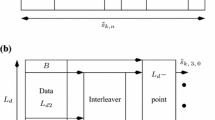Abstract
In the framework of digital video broadcasting by satellite-second generation (DVB-S2), we analyze a faster-than-Nyquist (FTN) system based on turbo equalization and low-density parity-check (LDPC) codes. Truncated maximum a posteriori and minimum mean square error equalizers provide a reduced-complexity implementation of the FTN system. On the other hand, LDPC codes allow us to demonstrate attractive performance results over an additive white Gaussian noise channel while increasing spectral efficiency beyond the Nyquist rate and keeping a complexity comparable to that of a current DVB-S2 modem.














Similar content being viewed by others
Notes
Such condition is sometimes not fulfilled and an approximate factorization is performed.
References
Bahl, L., Cocke, J., Jelinek, F., & Raviv, J. (2006). Optimal decoding of linear codes for minimizing symbol error rate (corresp.). IEEE Transactions on Information Theory, 20(2), 284–287. doi:10.1109/TIT.1974.1055186.
Barry, J., Lee, E., & Messerschmitt, D. (2004). Digital communication (3rd ed.). berlin: Springer. doi:10.1007/978-1-4615-0227-2.
Christensen, O. (2008). Frames and bases: An introductory course. Basel: Birkhauser.
Colavolpe, G., & Barbieri, A. (2005). On MAP symbol detection for ISI channels using the Ungerboeck observation model. IEEE Communications Letters, 9(8), 720–722. doi:10.1109/LCOMM.2005.1496594.
Douillard, C., Jézéquel, M., Berrou, C., Picart, A., Didier, P., & Glavieux, A. (1995). Iterative correction of intersymbol interference: Turbo-equalization. European Transactions on Telecommunications, 6(5), 507–511. doi:10.1002/ett.4460060506.
Emrick, R., Cruz, P., Carvalho, N., Gao, S., Quay, R., & Waltereit, P. (2014). The sky’s the limit: Key technology and market trends in satellite communications. Microwave Magazine, IEEE, 15(2), 65–78. doi:10.1109/MMM.2013.2296212.
ETSI. (2009). EN 302 307 digital video broadcasting (DVB). In Second generation framing structure, channel coding and modulation systems for Broadcasting, Interactive services, News Gathering and other broadband satellite applications (DVB-S2).
ETSI. (2014). EN 302 307-2 digital video broadcasting (DVB). Second generation framing structure, channel coding and modulation systems for Broadcasting, Interactive Services, News Gathering and other broadband satellite applications Part II: S2—Extensions (DVB-S2X).
Forney, G. (1972). Maximum-likelihood sequence estimation of digital sequences in the presence of intersymbol interference. IEEE Transactions on Information Theory, 18(3), 363–378.
Hagenauer, J. (2004). The EXIT chart—introduction to extrinsic information transfer in iterative processing. In: Proceedings of 12th European signal processing conference (EUSIPCO) (pp. 1541–1548).
Koetter, R., Singer, A., & Tuchler, M. (2004). Turbo equalization. Signal Processing Magazine, IEEE, 21(1), 67–80. doi:10.1109/MSP.2004.1267050.
Liveris, A., & Georghiades, C. (2003). Exploiting faster-than-Nyquist signaling. IEEE Transactions on Communications, 51(9), 1502–1511. doi:10.1109/TCOMM.2003.816943.
Maalouli, G., & Bannister, B. (2014). Performance analysis of a MMSE turbo equalizer with LDPC in a FTN channel with application to digital video broadcast. In: 2014 48th Asilomar conference on signals, systems and computers (pp. 1871–1875). doi:10.1109/ACSSC.2014.7094793
Mazo, E. (1975). Faster-than-Nyquist signaling. The Bell System Technical Journal, 54, 1451–1462.
McGuire, M., & Sima, M. (2010). Discrete time faster-than-Nyquist signalling. In: Global telecommunications conference (GLOBECOM 2010), 2010 IEEE (pp. 1 –5). doi:10.1109/GLOCOM.2010.5683272
Nyquist, H. (1928). Certain topics in telegraph transmission theory. Transactions of the American Institute of Electrical Engineers, 47(2), 617–644. doi:10.1109/T-AIEE.1928.5055024.
Oppenheim, A., Schafer, R., & Buck, J. (2008). Discrete-time signal processing (2nd ed.). London: Pearson Higher Education.
Pham, N., Anderson, J., Rusek, F., Freixe, J., & Bonnaud, A. (2013). Exploring faster-than-Nyquist for satellite direct broadcasting. In AIAA international communications satellite systems conference (pp. 16–26).
Prlja, A., & Anderson, J. (2012). Reduced-complexity receivers for strongly narrowband intersymbol interference introduced by faster-than-Nyquist signaling. IEEE Transactions on Communications, 60(9), 2591–2601. doi:10.1109/TCOMM.2012.070912.110296.
Rusek, F., Loncar, M., & Prlja, A. (2007). A comparison of ungerboeck and forney models for reduced-complexity isi equalization. In Global telecommunications conference, 2007. GLOBECOM ’07. IEEE (pp. 1431–1436). doi:10.1109/GLOCOM.2007.275
Selesnick, I. (2012). Spectral factorization, polynomial root finding and the leja ordering. Lecture Notes. http://eeweb.poly.edu/iselesni/EL713/sfact/sfact.pdf
Tüchler, M., Koetter, R., & Singer, A. (2002). Turbo equalization: principles and new results. IEEE Transactions on Communications, 50(5), 754–767. doi:10.1109/TCOMM.2002.1006557.
Tüchler, M., & Singer, A. (2011). Turbo equalization: An overview. IEEE Transactions on Information Theory, 57(2), 920–952. doi:10.1109/TIT.2010.2096033.
Acknowledgements
This work has been supported by the Direction Générale de l’Armement (DGA) under the CIFRE Grant 10/2015/DGA.
Author information
Authors and Affiliations
Corresponding author
Rights and permissions
About this article
Cite this article
Abelló, A., Roque, D., Freixe, JM. et al. Faster-than-Nyquist signaling: on linear and non-linear reduced-complexity turbo equalization. Analog Integr Circ Sig Process 91, 267–276 (2017). https://doi.org/10.1007/s10470-017-0937-z
Received:
Revised:
Accepted:
Published:
Issue Date:
DOI: https://doi.org/10.1007/s10470-017-0937-z
Keywords
- Faster-than-Nyquist
- Turbo equalization
- Low-density parity-check codes
- Truncated trellis equalizers
- Linear equalizers




